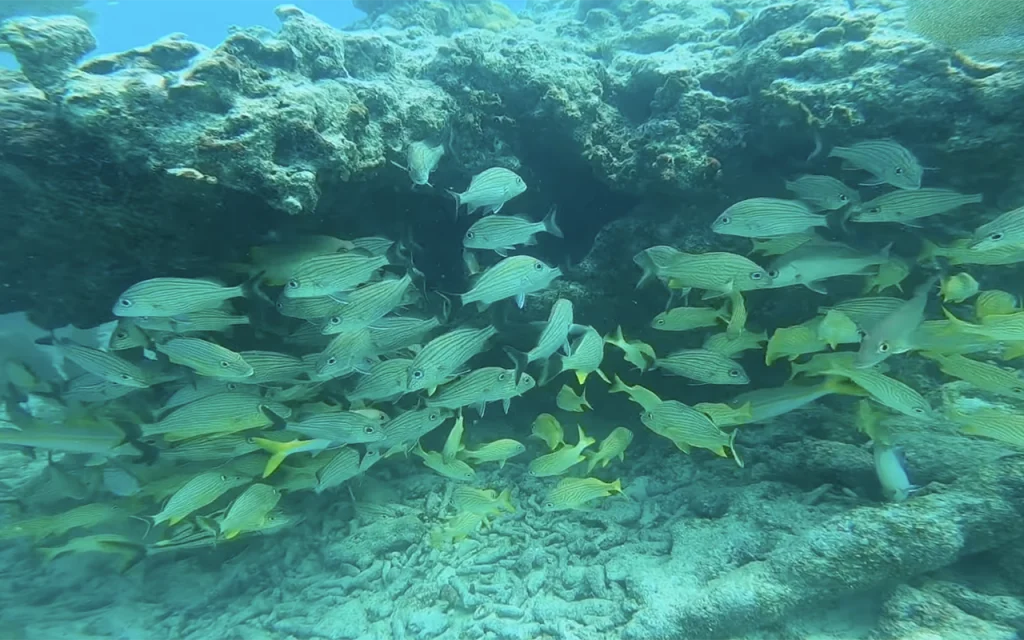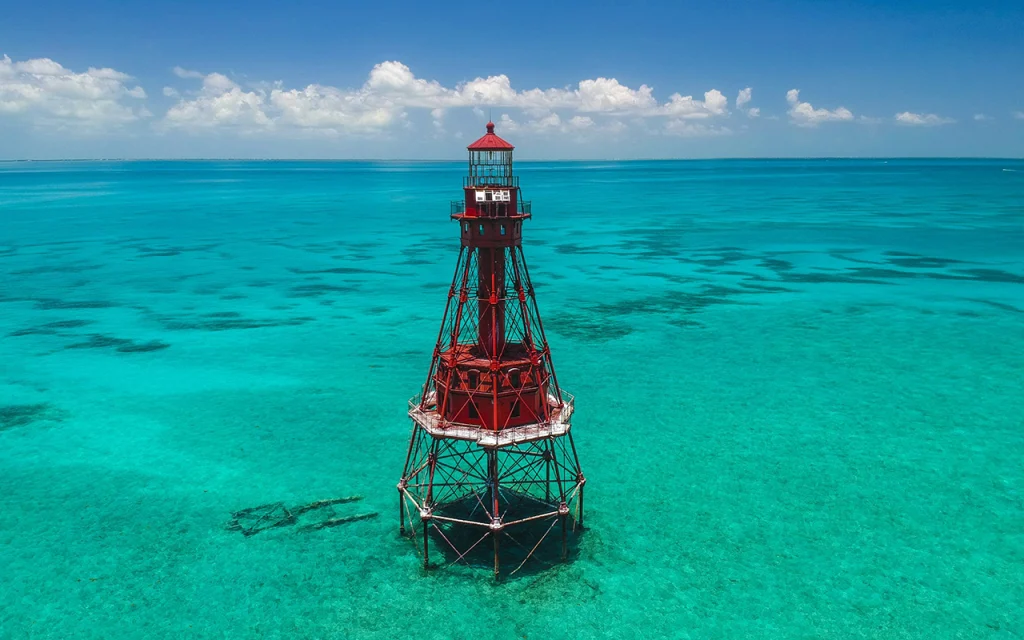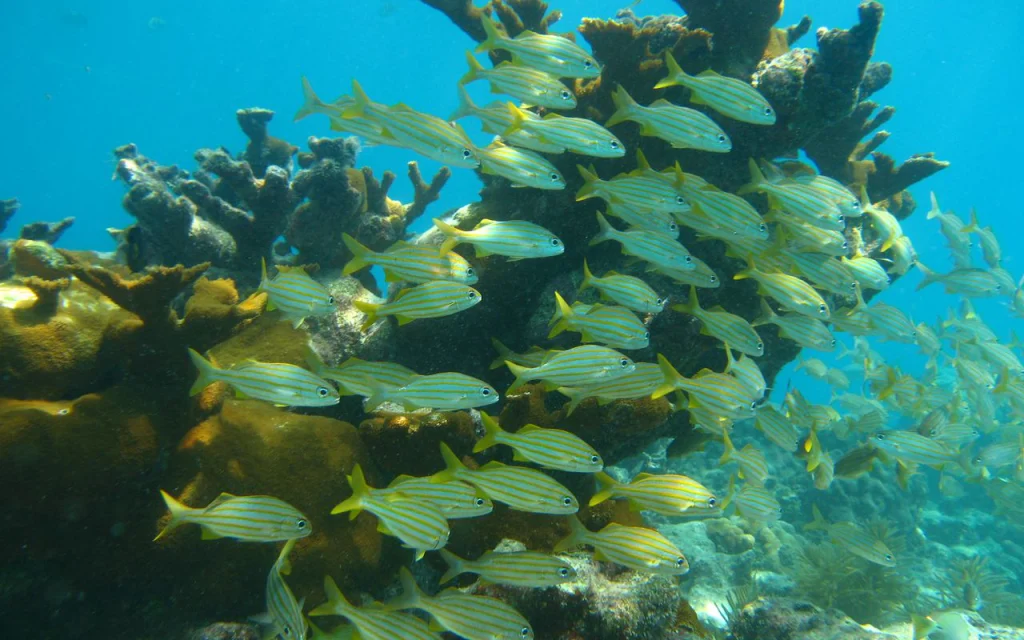Table of Contents

American Shoal is well-regarded among divers for its beautiful underwater scenery and accessibility, making it a popular choice in the Florida Keys.
Article at a Glance
- Location: American Shoal is situated in the Florida Keys, known for its stunning coral reefs and diverse marine life.
- Depth: The dive site features an average depth of 30 feet, with a maximum depth of 45 feet, making it accessible for divers of all skill levels.
- Visibility: Divers can typically enjoy visibility ranging from 30 to 100 feet, especially during peak diving seasons.
- Best Time to Dive: The ideal months for diving are January to May and October to December, when conditions are generally more favorable.
- Marine Life: The site is home to a variety of species, including colorful reef fish, corals, and larger predators like barracuda and sharks.
- Suitability: American Shoal is suitable for both beginners and advanced divers, offering opportunities for skill development and exploration.
- Unique Features: Highlights include the historic American Shoal Lighthouse and vibrant coral formations that enhance the underwater experience.
American Shoal Key West
American Shoal is a beautiful coral reef located in the Florida Keys, offering an exciting diving experience for both novice and experienced divers. While it’s not directly in Key West, it’s within reach for dive trips from the Lower Keys area.
Scuba Steve’s, a full-service dive center in the Florida Keys, offers dive trips to American Shoal. Their dive excursions cover various stunning locations, including the coral reefs of American Shoal and Looe Key, as well as shipwrecks in the Lower Keys and Key West area.
Diving at American Shoal
American Shoal is known for its vibrant coral formations and diverse marine life. When diving here, you can expect to see:
- Colorful tropical fish
- Various coral species
- Potential sightings of larger marine animals
Planning Your Dive
To dive American Shoal from the Key West area:
- Book a trip with a reputable dive operator like Scuba Steve’s.
- Ensure you have the necessary certification for the planned dive.
- Rent or bring appropriate diving equipment.
Scuba Steve’s offers a range of services to support your diving adventure:
- Full retail store with extensive inventory
- High-quality rental gear and tanks
- Air and nitrox fills
- Equipment repairs and services
What Marine Life Can I Expect To See?
Fish Species
- Colorful Reef Fish: The area is home to over 500 species of fish, including:
- Blue Tang: Bright blue with a yellow tail, commonly spotted year-round.
- Mahi-Mahi (Dolphinfish): Known for its vibrant yellow and green colors.
- Yellowtail Snapper: Recognizable by its bright yellow stripe.
- Predatory Fish: You may also see larger fish such as:
- Great Barracuda: A common sight in the waters around the reef.
- Groupers and Snappers: Various species inhabit the reefs.
Invertebrates
- Coral Species: The reefs support over 45 species of stony corals and numerous soft corals like gorgonians.
- Octopuses: Common species include the Common Octopus and Caribbean Reef Octopus, often found hiding in crevices.
- Lobsters and Crustaceans: Look for Caribbean Spiny Lobster and various shrimp species.
Marine Mammals and Reptiles
- Sea Turtles: You might encounter several species, including Loggerhead and Green Turtles, which are often seen in these waters.
- Dolphins: Bottlenose dolphins are frequently spotted in the area, known for their playful behavior.
Other Marine Life
- Stingrays: Southern and Atlantic stingrays can be seen gliding along the sandy bottoms.
- Sharks: Species such as Nurse Sharks and Lemon Sharks inhabit the area but are generally non-aggressive toward divers.

What Do Divers Say About This Site?
General Impressions
- Accessibility for Novice Divers: American Shoal is often recommended for novice divers due to its relatively shallow depths (average around 30 feet) and good visibility, which typically ranges from 20 to 100 feet. This makes it an excellent site for those new to diving.
- Marine Life: Divers report a rich diversity of marine life, including lobsters, groupers, hogfish, and a variety of tropical fish. The presence of coral formations adds to the visual appeal and biodiversity of the site.
Visibility and Conditions
- Visibility: Many divers appreciate the clear waters at American Shoal, which enhances the overall diving experience by allowing for better observation of marine life and coral structures.
- Depth: The site’s maximum depth of 45 feet is considered manageable, making it a comfortable dive for those who may not be experienced in deeper waters.
Dive Operations Feedback
- Mixed Reviews on Dive Shops: While divers enjoy the site itself, opinions on local dive operators can vary. Some divers express concerns about overcrowded boats or less experienced crews at certain dive shops in Key West. Recommendations often lean towards operators known for smaller groups and personalized service.
Key Information
| Category | Details |
|---|---|
| Location | American Shoal, Florida Keys |
| Average Depth | 30 feet |
| Maximum Depth | 45 feet |
| Visibility | 30 to 100 feet |
| Best Time to Dive | January to May; October to December |
| Suitable for Beginners | Yes, due to shallow depths and calm conditions |
| Suitable for Advanced Divers | Yes, for exploration and skill refinement |
| Marine Life | Colorful reef fish, corals, barracuda, sharks |
| Notable Features | American Shoal Lighthouse, vibrant coral formations |
| Dive Conditions | Generally calm with mild currents |
| Recommended Dive Operators | Local dive shops offering guided dives |
Highlights of Diving This Site?
Marine Life Diversity
- Colorful Reef Fish: The Florida Keys are home to a wide variety of tropical fish species, including angelfish, parrotfish, and wrasses1.
- Larger Predators: You might encounter barracuda, groupers, and various shark species.
Coral Formations
- The area is known for its vibrant coral reefs, which provide habitat for numerous marine species.
- You can expect to see various coral formations, including soft corals like sea fans.
Visibility and Conditions
- The Florida Keys generally offer good visibility, which enhances the diving experience.
- Shallow depths make it suitable for divers of various skill levels.
Unique Underwater Landscapes
- While not specifically about American Shoal, the Florida Keys are known for interesting underwater topography, including walls and reef structures.
Potential for Pelagic Encounters
- Depending on the season and conditions, there’s a possibility of encountering larger pelagic species like rays or even whale sharks.
Night Diving Opportunities
- Many reef sites in the Florida Keys offer excellent night diving, revealing a different array of marine life.
My Favorite Dive Computers
I have compared the 3 top diving computers for each category to help making the right choice easier:
Iconic Spots At This Site
American Shoal Lighthouse
- Historical Significance: The American Shoal Lighthouse is a prominent landmark, marking the reef and serving as a navigational aid for boats. It is the last of its kind in the Florida Keys, adding a historical element to dives in the area.
Coral Formations
- Diverse Coral Life: The reef features various coral species, providing habitat for numerous marine organisms. Divers can explore vibrant coral gardens that support a rich ecosystem.
Marine Life
- Abundant Fish Species: Divers frequently encounter a variety of fish, including colorful reef fish, groupers, and potentially larger species like barracuda and sharks. The biodiversity makes each dive unique and exciting.
Proximity to Other Dive Sites
- Connected Dive Locations: American Shoal is closely linked to other dive sites like Maryland and Pelican Shoals, allowing divers to explore multiple locations in one trip.
Scenic Underwater Landscapes
- Visual Appeal: The combination of clear waters, vibrant corals, and diverse marine life creates breathtaking underwater scenery ideal for photography and exploration.
Less Crowded Experience
- Secluded Diving: Due to its distance from shore, American Shoal tends to be less crowded than other popular dive sites, providing a more tranquil diving experience.
Environmental Conservation Efforts at American Shoal
Florida Keys National Marine Sanctuary
American Shoal is located within the Florida Keys National Marine Sanctuary, established in 1990 to protect the marine ecosystems surrounding the Florida Keys13. The sanctuary:
- Covers 3,800 square nautical miles of waters
- Protects coral reefs, seagrass beds, and mangrove-fringed islands
- Safeguards over 6,000 species of marine life
Coral Conservation
The Florida Keys reef tract, including American Shoal, has faced significant challenges:
- Coral populations have declined by over 90% in the past four decades
- Threats include hurricanes, pollution, vessel groundings, overfishing, disease, and climate change
In response, several initiatives have been launched:
- Mission: Iconic Reefs, a large-scale coral restoration project by NOAA
- Collaborative efforts involving government agencies, research institutions, and non-profit organizations
Mangrove Protection
While not directly at American Shoal, mangrove conservation in the Keys indirectly benefits the reef ecosystem:
- The Mangrove Trimming & Preservation Act of 1996 made it illegal to remove or damage mangroves in Florida
- Restoration projects are underway to replant mangroves in areas where they’ve been lost
Seagrass Conservation
Seagrass beds, which are crucial to the reef ecosystem, are protected:
- Hefty fines are imposed on boaters who damage seagrass beds
- Restoration projects involve transplanting or seeding new seagrass in damaged areas
Zoning and Management
The Florida Keys National Marine Sanctuary uses zoning to manage resources:
- Reduces user conflicts and minimizes impact on heavily used reef areas
- Management techniques are based on monitoring data for reefs, water quality, fish, and invertebrates

Maximizing Your Diving Experience at American Shoal
Dive Planning
- Best Time to Visit: The best periods for diving at American Shoal are generally January through May and October through December, when water conditions are typically more favorable.
- Depth Range: American Shoal offers diverse diving opportunities with depths ranging from 4 feet to 94 feet, catering to both novice and advanced divers.
Dive Site Highlights
- American Shoal Lighthouse: This 109-foot-tall lighthouse, completed in 1880, is a focal point of the dive site. It stands in about 5 feet of water, offering a unique shallow diving experience.
- Marine Life: Expect to see barracuda, small schools of grunts, snapper, and sergeant majors in the flat sand and rubble areas beneath the lighthouse.
- Reef Exploration: The site features various coral formations and is connected to nearby Maryland and Pelican Shoals, providing opportunities for extended exploration.
Responsible Diving Practices
- Maintain Proper Buoyancy: Practice and use proper weighting to avoid contact with the reef.
- Avoid Contact: Never stand or rest on corals. Use proper horizontal dive posture with feet slightly elevated.
- Secure Equipment: Ensure all gear is secured and doesn’t contact the reef.
- Respect Marine Life: Do not touch, handle, feed, or chase marine animals.
- Leave No Trace: Don’t collect “souvenirs” from the reef, as everything has a purpose in the ecosystem.
- Use Blue Star Operators: Book with Blue Star certified dive operators who are committed to sustainable practices.
Additional Tips
- Photography: The lighthouse and surrounding reef offer excellent photo opportunities, especially in good visibility conditions.
- Currents: Be aware of potential currents, particularly in deeper areas of the reef.
- Explore Varied Depths: Take advantage of the site’s depth range to experience different marine environments.
Capturing Memories at American Shoal: Photography Tips
Preparation Before the Dive
- Know Your Equipment: Familiarize yourself with your camera settings and housing before entering the water. This will help you quickly adjust settings as needed during your dive.
- Check Your Buoyancy: Achieving proper buoyancy is crucial for stable shots. Practice buoyancy control to avoid unnecessary movement that can blur your images.
Underwater Photography Techniques
- Use Natural Light: Whenever possible, shoot with natural light, especially in shallow waters. Position yourself so that the sun is behind you to illuminate your subjects without creating glare or backscatter from particles in the water.
- Get Close: Water can distort images, so getting as close as possible to your subject helps reduce the amount of water between your lens and the subject, resulting in clearer photos.
- Incorporate Divers: Including fellow divers in your shots can add scale and interest. Ensure they have good buoyancy and trim for the best results. Use colorful gear to enhance visual appeal.
Composition Tips
- Plan Your Shots: Think ahead about what you want to capture. Consider using silhouettes against vibrant backgrounds for dramatic effects, especially if lighting conditions are not ideal.
- Creative Framing: Use natural elements like coral formations or the diver’s silhouette to frame your subject. This can create more engaging compositions.
- Split-Level Shots: If conditions allow, try capturing split-level shots that show both underwater life and the surface above. This technique can provide unique perspectives and context for your images.
Lighting Techniques
- Use a Torch: A strong underwater torch can illuminate specific areas or subjects, creating dynamic lighting effects. This is particularly useful in darker environments like wrecks or caves.
- Adjust Strobe Settings: If using strobes, position them correctly to avoid overexposing lighter subjects. Experiment with different settings to achieve the desired effect without losing detail.
Post-Dive Considerations
- Review and Edit: After your dive, review your images and edit them as needed. Look for opportunities to enhance colors or adjust brightness to bring out the beauty of your underwater scenes.
Frequently Asked Questions
When is the best time to dive American Shoal?
The best time to dive at American Shoal is typically from January to May and October to December. During these months, water conditions are generally more favorable, with good visibility and comfortable water temperatures.
Winter to Spring (January – May): This period is ideal for diving due to warmer water temperatures and clearer visibility. It is also less crowded compared to the summer months, allowing for a more enjoyable experience.
Fall (October – December): This time can also be excellent for diving, as the weather is usually stable, and the marine life remains active. Visibility tends to improve after the summer, making it a great time for underwater photography and exploration.
Avoiding the peak summer months (June to September) is advisable if you prefer fewer crowds and better conditions. Overall, planning your dive during these optimal months will enhance your experience at American Shoal.
What is the visibility like while diving American Shoal?
Visibility while diving at American Shoal can vary, but it is generally favorable.
Typical Visibility Range: Divers can expect visibility to range from 30 to 100 feetdepending on the time of year and environmental conditions. Reports indicate that visibility is often excellent during the winter and spring months, reaching up to 90-100 feet on good days.
Seasonal Variations: During the peak diving seasons (January to May and October to December), visibility tends to be better. However, in the summer months, conditions can fluctuate due to factors such as increased boat traffic and potential algal blooms, which may reduce clarity.
Environmental Factors: Visibility can also be affected by weather conditions and water currents. For instance, heavy rain or storms can lead to decreased visibility due to runoff and sediment disturbance.
How deep are the dives at American Shoal?
Diving at American Shoal typically features an average depth of 30 feet with a maximum depth of 45 feet. This range makes it accessible for novice divers while still providing opportunities for more experienced divers to explore deeper areas.
The site is characterized by its relatively shallow depths, allowing for enjoyable diving experiences without the complexities associated with deeper dives.
Is American Shoal suitable for beginners?
Yes, American Shoal is suitable for beginners.
Shallow Depths
Average Depth: The average depth at American Shoal is around 30 feet, with a maximum depth of 45 feet. This shallow environment makes it manageable for new divers who may not yet be comfortable with deeper dives.
Good Visibility
Visibility Conditions: Divers can generally expect visibility ranging from 30 to 100 feet, especially during peak diving seasons. Clear waters enhance the experience for beginners, allowing them to see marine life and coral formations more easily.
Calm Conditions
Gentle Currents: The site typically features mild currents, which can be less intimidating for beginners compared to stronger currents found at other dive sites.
Abundant Marine Life
Diverse Ecosystem: American Shoal is home to a variety of marine life, including colorful reef fish and coral formations. The opportunity to observe diverse species can boost the confidence and enjoyment of novice divers.
Supportive Dive Operators
Guided Dives: Many dive operators in the Florida Keys, including those that offer trips to American Shoal, provide guided dives with experienced instructors. This support is invaluable for beginners, ensuring they feel safe and receive assistance as needed.
Is American Shoal suitable for advanced divers?
Yes, American Shoal can be suitable for advanced divers, although its shallow depths and relatively calm conditions primarily cater to beginners.
Depth and Exploration
Depth Range: With an average depth of 30 feet and a maximum of 45 feet, advanced divers may find the site less challenging compared to deeper dive locations. However, the shallow environment allows for extended bottom times and the opportunity to explore various marine habitats.
Diverse Marine Life
Rich Biodiversity: Advanced divers can enjoy the vibrant marine life, including colorful reef fish, corals, and potentially larger species like barracuda and sharks. The diversity provides ample opportunities for underwater photography and observation.
Potential for Specialty Dives
Exploration of Nearby Sites: Advanced divers can use American Shoal as a starting point to explore nearby dive sites, such as Maryland and Pelican Shoals, which may offer different experiences.
Skill Development
Refining Skills: Advanced divers can take advantage of the site to practice skills such as navigation, buoyancy control, and underwater photography in a less stressful environment.
Guided Dives
Professional Guidance: Many dive operators offer guided dives that can enhance the experience for advanced divers by providing insights into the local ecology and dive conditions.





